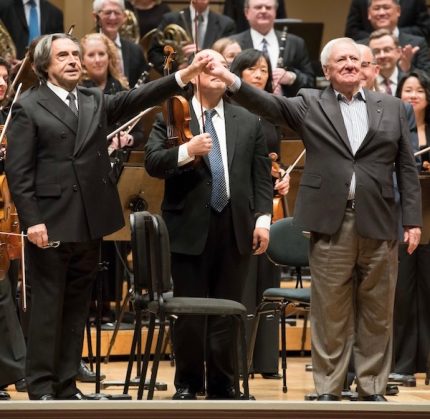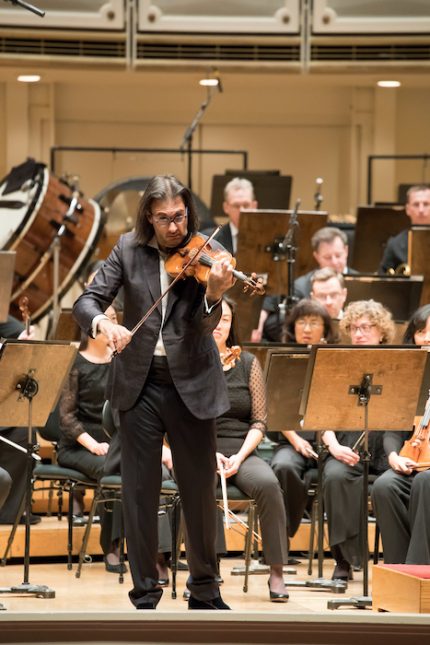A world premiere, quirky Beethoven and noisy Liszt fill up a CSO matinee

The vagaries of scheduling meant that the first of this season’s three Chicago Symphony Orchestra world premieres to be led by Riccardo Muti took place at a matinee concert on Friday.
The work was DREAM for Orchestra by Bernard Rands, a CSO commission to mark the composer’s 85th birthday.
Long resident in Chicago—he is married to fellow composer and University of Chicago professor Augusta Read Thomas—Rands is one of the handful of living composers whose music has enjoyed consistent Muti favor. The conductor appointed Rands composer-in-residence of the Philadelphia Orchestra during his tenure there, and Muti premiered Rands’ Danza Petrificada with the CSO in 2011, later taking the work on tour.
DREAM is not a programmatic work based on any single specific dream, says the composer, but rather reflects “some of the general characteristics of dreams”— their “unpredictable and fantastic juxtapositions,” “exotic simultaneities,” “intense clarity and opaque chaos.”
A quiet tam-tam stroke begins the work, followed by rising winds, and angular string fragments. Chimes appear at irregular intervals and the music sometimes comes to a full stop, as dreams do, before starting again. Rands mines an extended melody he has used in previous works, which serves as a leitmotif of sorts, surfacing amid the elliptical phrases, abrupt transitions and fragmented, scurrying strings. The tolling chimes reappear and seem to partially quell the oppositional elements, and the lyrical theme rises to a resplendent string statement over the restless churning underneath.
Rands’ score is meticulously crafted yet flows naturally and is wholly compelling. Like many contemporary works, DREAM is scored for super-sized percussion battery manned by four players. Yet while there are imposing climaxes, Rands wields the percussion and, indeed, the full symphonic resources, with striking subtlety. Packed with arresting incident and shifting, flowing momentum, the quarter-hour duration seemed to fly by in a few minutes.
As is often the case with a world premiere, Muti was at his finest Friday, leading a gleaming, scrupulously balanced performance that gave first-class advocacy to Rands’ superb new work.
The first half of the concert was devoted to Beethoven’s Violin Concerto, with Leonidas Kavakos as soloist.

The Greek violinist is one of those musicians that constantly keep you guessing. Kavakos can be terrific, as in his blazing Shostakovich performances with the CSO last season. Other times he can be uneven (his Brahms trios with Yo-Yo Ma and Emanuel Ax). And sometimes he can be just plain weird (his 2011 Sibelius).
Friday afternoon’s Beethoven showed Kavakos alternating between his strange and inspired modes, probing moments mixing with the odd and self-aggrandizing.
Kavakos has never been a power player but throughout the concerto’s long first movement his slender tone felt at least one size too small for the music. Even with Muti scaling down his accompaniment to complement his soloist, there was an odd disjunct between the dramatic, surging orchestra and Kavakos’s laid-back musing. The soloist’s fractional hesitations on position changes were eyebrow-raising as well.
One will likely never hear Beethoven’s concerto performed with more numerous or outré cadenzas than Kavakos served up Friday. In the opening movement he resurrected Beethoven’s bizarre cadenza (here slightly retooled) for the piano concerto arrangement, which devolves into an extended duo for violin and timpani. To his credit, Muti let his soloist have his fun, looking bemused at Kavakos’s cadential high-jinks.
The violinist was at his most convincing in the Larghetto, playing with silver-toned purity and exploring an array of subtle hues and intimate expression. Despite at least one cadenza too many, Kavakos brought easy bravura and a playful joyous quality to the Rondo, qualities that better suited the music.
The concert closed with Franz Liszt’s Mazeppa. Muti has an inexplicable fondness for the Hungarian composer’s tone-poem potboilers, and led a fiery, no-holds-barred performance, giving Liszt’s unhealthy vulgarity rich opulence and silver-screen swagger. If you like this sort of thing, this is the sort of thing you will like.
Amazingly, for a piece that was a pops staple for much of the 20th century, Friday’s CSO concert marked the orchestra’s first performance of Mazeppa since 1947. Every 72 years or so seems just about right.
The program will be repeated 8 p.m. Saturday and 7:30 p.m. Tuesday. cso.org; 312-294-3000.
Posted in Performances


